Abstract
Mesenteric traction syndrome consists of sudden tachycardia, hypotension, and cutaneous hyperemia, and frequently occurs during mesenteric traction in patients undergoing abdominal aortic aneurysm (AAA) reconstructive surgery. The etiology and clinical impact of this phenomenon are unknown, but the symptoms suggest a release of vasoactive materials from the mesenteric vascular bed. Thirty-one patients who underwent AAA surgery were studied. Mesenteric traction was accompanied by a decrease in systolic (p = 0.005) and diastolic (p less than 0.05) blood pressures, and in systemic vascular resistance (p less than 0.005), and was accompanied by an increase in heart rate (HR) (p less than 0.005), and cardiac output (p = 0.01). These hemodynamic changes coincided with an increase (p less than 0.001) in plasma concentrations of 6-keto-prostaglandin F1 (6-K-PGF1). No apparent change was found in prostaglandin E2, thromboxane B2, and histamine concentrations. The concentration of 6-K-PGF1 was correlated with diastolic blood pressure (r = -0.52, p less than 0.005) and HR (r = 0.65, p less than 0.001). Cutaneous hyperemia was observed in 58% of the patients. In an additional six patients, who had taken aspirin daily before AAA surgery, no significant changes were observed in the hemodynamic measurements or 6-K-PGF1 concentrations. These data suggest that mesenteric traction syndrome may be mediated at least in part by a selective release of prostacyclin.
Full text
PDF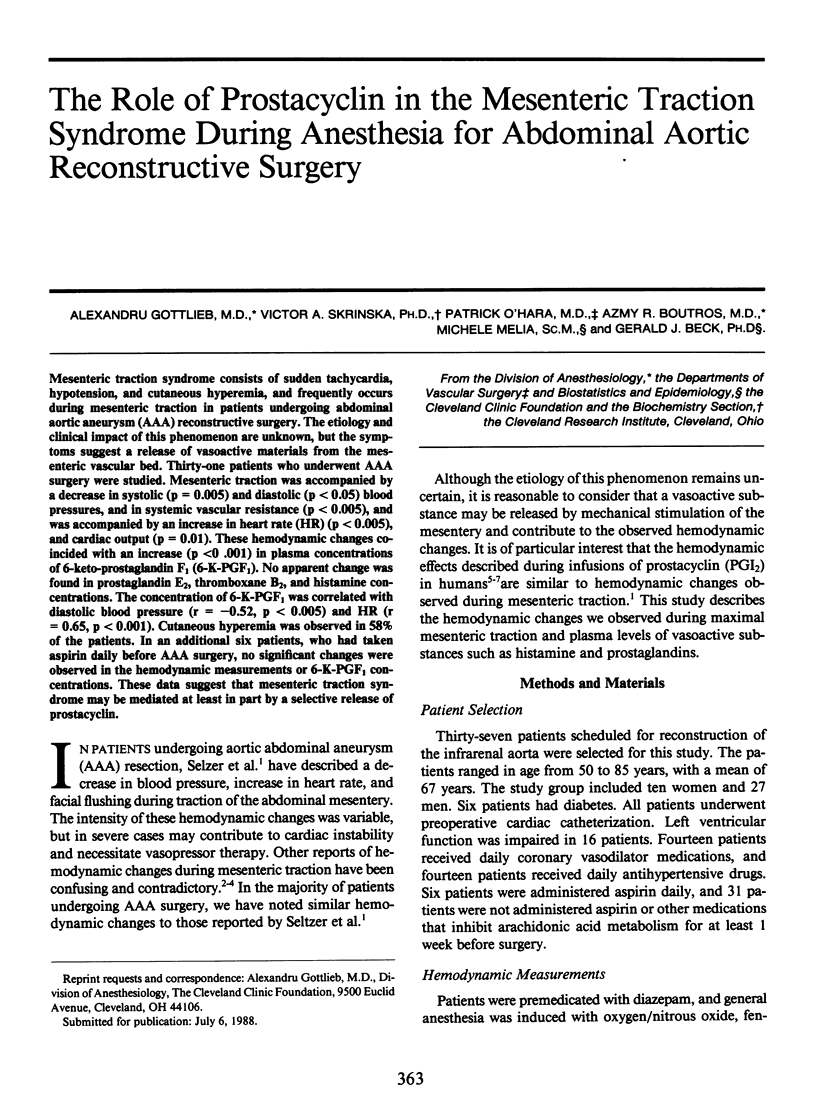
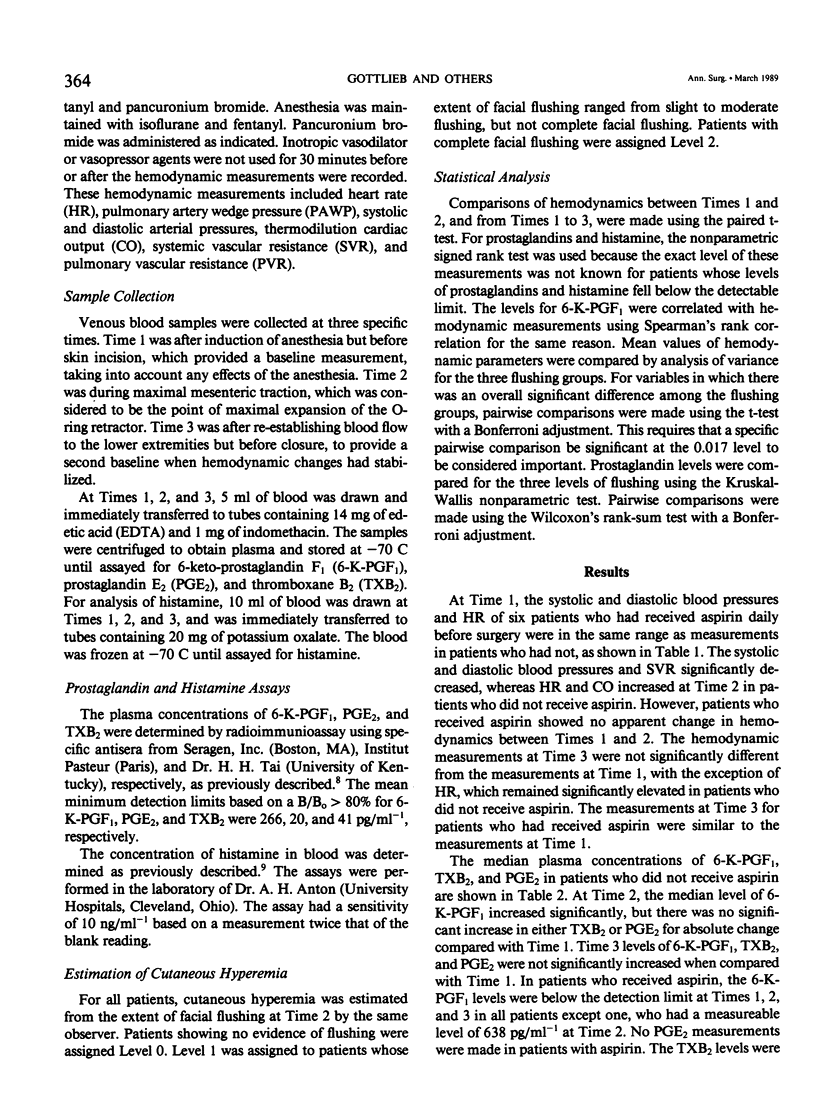
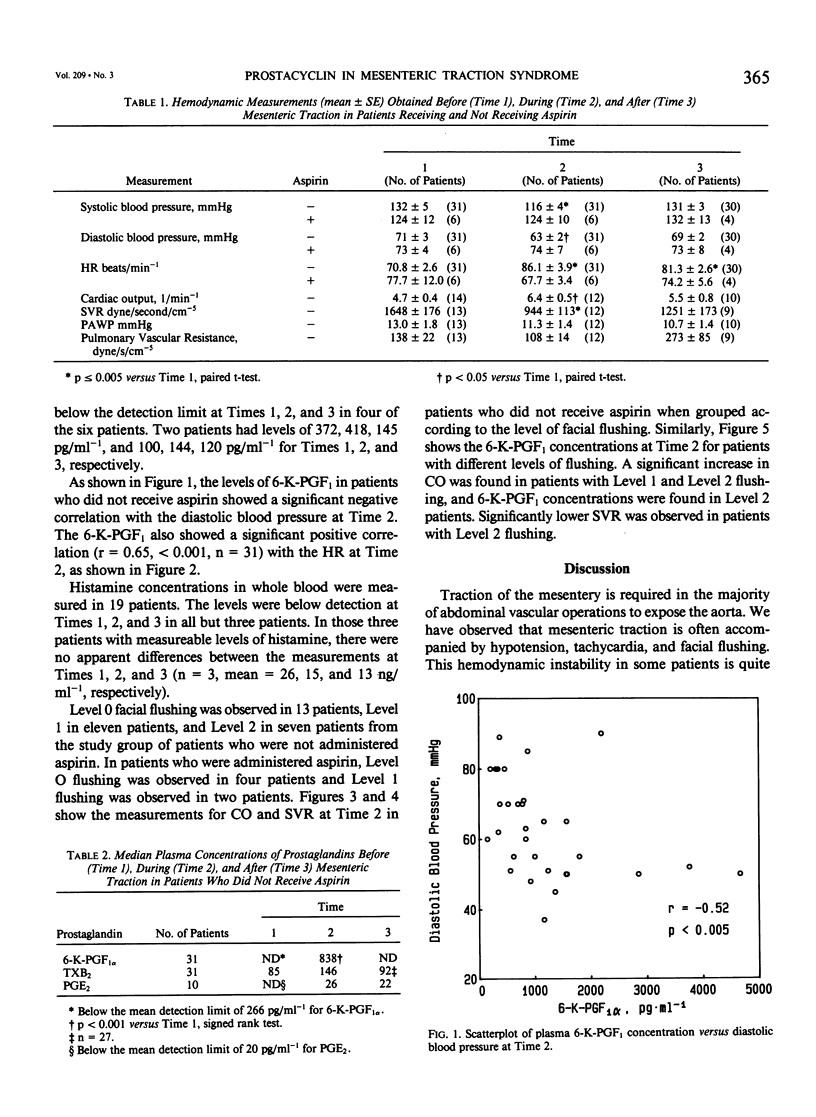
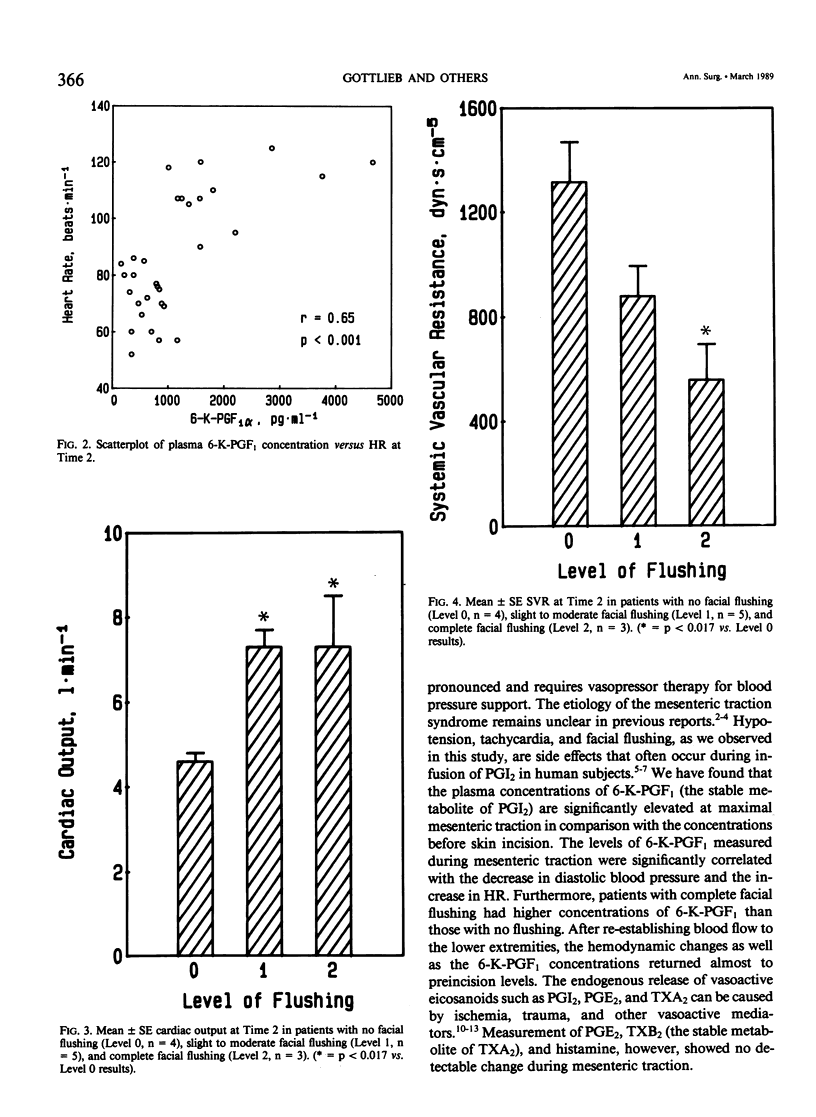
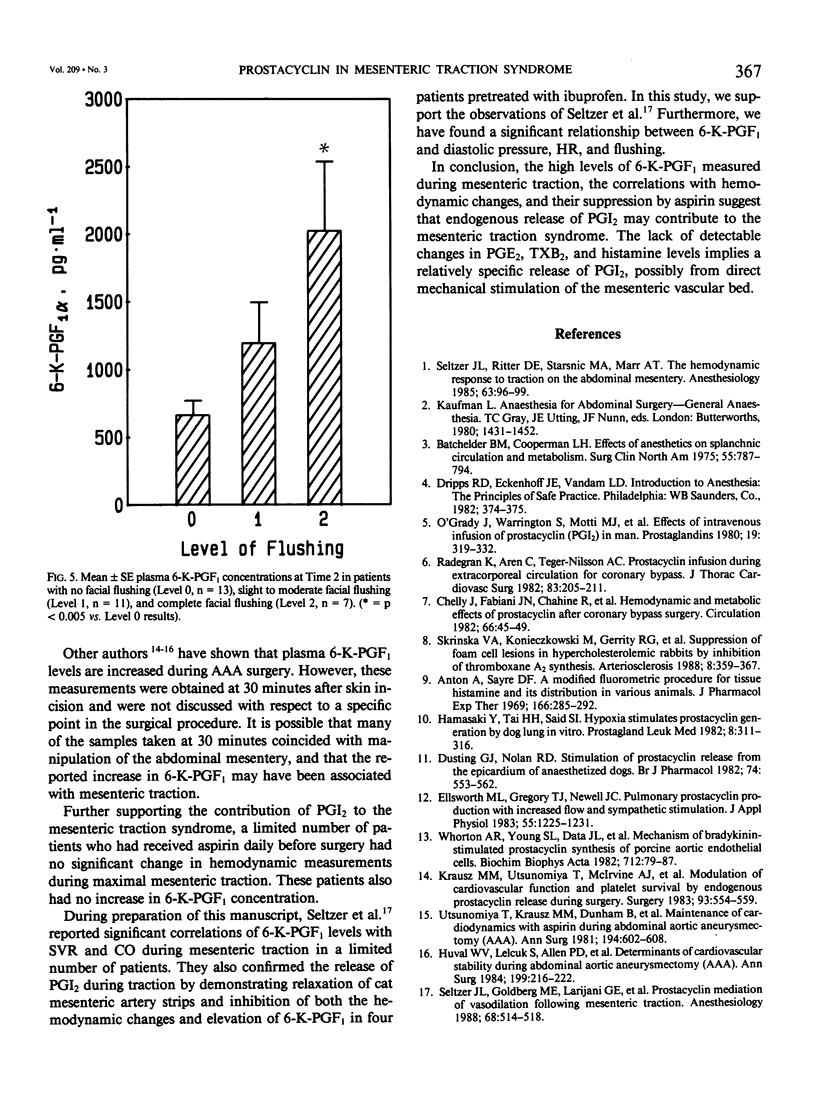
Selected References
These references are in PubMed. This may not be the complete list of references from this article.
- Anton A. H., Sayre D. F. A modified fluorometric procedure for tissue histamine and its distribution in various animals. J Pharmacol Exp Ther. 1969 Apr;166(2):285–290. [PubMed] [Google Scholar]
- Batchelder B. M., Cooperman L. H. Effects of anesthetics on splanchnic circulation and metabolism. Surg Clin North Am. 1975 Aug;55(4):787–794. doi: 10.1016/s0039-6109(16)40681-x. [DOI] [PubMed] [Google Scholar]
- Dusting G. J., Nolan R. D. Stimulation of prostacyclin release from the epicardium of anaesthetized dogs. Br J Pharmacol. 1981 Nov;74(3):553–562. doi: 10.1111/j.1476-5381.1981.tb10464.x. [DOI] [PMC free article] [PubMed] [Google Scholar]
- Ellsworth M. L., Gregory T. J., Newell J. C. Pulmonary prostacyclin production with increased flow and sympathetic stimulation. J Appl Physiol Respir Environ Exerc Physiol. 1983 Oct;55(4):1225–1231. doi: 10.1152/jappl.1983.55.4.1225. [DOI] [PubMed] [Google Scholar]
- Hamasaki Y., Tai H. H., Said S. I. Hypoxia stimulates prostacyclin generation by dog lung in vitro. Prostaglandins Leukot Med. 1982 Apr;8(4):311–316. doi: 10.1016/0262-1746(82)90054-3. [DOI] [PubMed] [Google Scholar]
- Huval W. V., Lelcuk S., Allen P. D., Mannick J. A., Shepro D., Hechtman H. B. Determinants of cardiovascular stability during abdominal aortic aneurysmectomy (AAA). Ann Surg. 1984 Feb;199(2):216–222. doi: 10.1097/00000658-198402000-00015. [DOI] [PMC free article] [PubMed] [Google Scholar]
- Krausz M. M., Utsunomiya T., McIrvine A. J., Allen P. D., Levine L., Mannick J. A., Shepro D., Hechtman H. B. Modulation of cardiovascular function and platelet survival by endogenous prostacyclin released during surgery. Surgery. 1983 Apr;93(4):554–559. [PubMed] [Google Scholar]
- O'Grady J., Warrington S., Moti M. J., Bunting S., Flower R., Fowle A. S., Higgs E. A., Moncada S. Effects of intravenous infusion of prostacyclin (PGI2) in man. Prostaglandins. 1980 Feb;19(2):319–332. doi: 10.1016/0090-6980(80)90030-1. [DOI] [PubMed] [Google Scholar]
- Rådegran K., Arén C., Teger-Nilsson A. C. Prostacyclin infusion during extracorporeal circulation foe coronary bypass. J Thorac Cardiovasc Surg. 1982 Feb;83(2):205–211. [PubMed] [Google Scholar]
- Seltzer J. L., Goldberg M. E., Larijani G. E., Ritter D. E., Starsnic M. A., Stahl G. L., Lefer A. M. Prostacyclin mediation of vasodilation following mesenteric traction. Anesthesiology. 1988 Apr;68(4):514–518. doi: 10.1097/00000542-198804000-00007. [DOI] [PubMed] [Google Scholar]
- Seltzer J. L., Ritter D. E., Starsnic M. A., Marr A. T. The hemodynamic response to traction on the abdominal mesentery. Anesthesiology. 1985 Jul;63(1):96–99. doi: 10.1097/00000542-198507000-00015. [DOI] [PubMed] [Google Scholar]
- Skrinska V. A., Konieczkowski M., Gerrity R. G., Galang C. F., Rebec M. V. Suppression of foam cell lesions in hypercholesterolemic rabbits by inhibition of thromboxane A2 synthesis. Arteriosclerosis. 1988 Jul-Aug;8(4):359–367. doi: 10.1161/01.atv.8.4.359. [DOI] [PubMed] [Google Scholar]
- Utsunomiya T., Krausz M. M., Dunham B., Mannick J. A., Allen P. D., Shepro D., Hechtman H. B. Maintenance of cardiodynamics with aspirin during abdominal aortic aneurysmectomy (AAA). Ann Surg. 1981 Nov;194(5):602–608. doi: 10.1097/00000658-198111000-00008. [DOI] [PMC free article] [PubMed] [Google Scholar]
- Whorton A. R., Young S. L., Data J. L., Barchowsky A., Kent R. S. Mechanism of bradykinin-stimulated prostacyclin synthesis in porcine aortic endothelial cells. Biochim Biophys Acta. 1982 Jul 20;712(1):79–87. doi: 10.1016/0005-2760(82)90087-x. [DOI] [PubMed] [Google Scholar]


